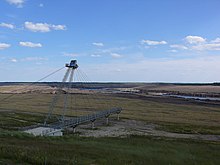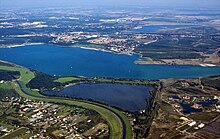Lusatian and Central German mining management company
| Lusatian and Central German mining management company
|
|
|---|---|
| legal form | GmbH |
| founding | 1995 |
| Seat | Senftenberg |
| management | Bernd Sablotny, Hans-Dieter Meyer |
| Number of employees | 845 (as of 2018) |
| Branch | Brown coal remediation |
| Website | www.lmbv.de |
| As of April 2, 2020 | |
The Lausitzer und Mitteldeutsche Bergbau-Verwaltungsgesellschaft mbH (LMBV) with its headquarters in Senftenberg manages, renovates and designs the successor landscapes of the lignite mining in the Lausitz ( Lausitz lignite district ) and in central Germany around Leipzig ( central German lignite district ) and stores disused potash, spar and ore mines in Saxony, Saxony-Anhalt and Thuringia. The company is wholly owned by the Federal Republic of Germany, represented by the Federal Ministry of Finance.
The LMBV improves the water quality of the opencast mining lakes ( opencast mining holes ), stabilizes the opencast mining embankments , sells the land and real estate, refurbishes and secures mining contaminated sites (mine damage ). It promotes the settlement of industry and commerce as well as the tourist use of the former mining areas ( land recycling ) . In the early days, the properties owned by LMBV included abandoned lignite power stations , briquette factories and coal handling points. The company initially owned around 100,000 hectares; two thirds of these have already been sold to subsequent users.
history
The LMBV, as the successor company of the Treuhandanstalt , emerged on August 31, 1995 from the merger of the Lausitzer Bergbau-Verwaltungsgesellschaft (LBV) and Mitteldeutsche Bergbau-Verwaltungsgesellschaft (MBV) founded in 1994 . It was founded on the initiative of the federal government and the states of Saxony , Saxony-Anhalt and Brandenburg . On September 8, 2014, the LMBV subsidiary company for the safekeeping and utilization of closed mining operations (GVV) merged with the LMBV. Since then, the tasks of the GVV have been continued in the area of Kali-Spat-Erz.
The LMBV initially had up to 20,000 employees.
financing
The LMBV is mainly financed by the federal government ( Federal Ministry of Finance ). The new federal states are participating in the basic renovation with 25 percent. The total investment so far has been around 8.5 billion euros.
A total of 227 million euros were invested in 2008, with 108 million euros going to Brandenburg, 83 million euros to Saxony, 34 million euros to Saxony-Anhalt and 1.6 million euros to Thuringia .
In 2012, the Federal Ministry of Finance expected expenditure of 1.2 billion euros for the federal and state governments by 2017. The financial restructuring costs from 1990 to 2012 amounted to 9.3 billion euros. In fact, the federal and state governments spent 10.6 billion euros to deal with contaminated sites from lignite mining by means of LMBV.
Until 2012, the so-called VA IV ( administrative agreement for brown coal refurbishment 2008–2012) was the financing basis, followed by the administrative agreement of February 20, 2013.
Projects


A large number of new artificial lakes have emerged in the Lausitz region and in central Germany. Not all of the lakes are completely flooded; for some it will take decades.
The largest project in Lausitz is the Lausitzer Seenland . Seven larger post-mining lakes are being created in the southern area of Leipzig ( Leipziger Neuseenland ).
Of 39 large open-cast lignite mines that were still in operation in eastern Germany in the early 1990s, seven have been privatized and 32 have been closed and transferred to LMBV. Among other things, the following opencast mines were abandoned:
- Berzdorf
- Bluno
- Breitenfeld
- Burghammer
- Cospudes
- Goitzsche (Goitsche)
- Aspen grove
- Heath VI
- Golpa North (" Ferropolis ")
- Gräbendorf
- Griffin Grove
- Coarser
- Great Kayna
- Holzweißig -W
- Klettwitz- North
- Koschen
- Leaf bush
- Lauchhammer
- Lohsa II
- Meuro
- Nachterstedt
- Olbersdorf
- Rösa
- Skado
- Schlabendorf-North
- Zwenkau
Fight against the ossification of the Spree

The Spree and other bodies of water in the Lausitz are affected to different degrees by ocher formation . The problem of the brown Spree probably has two causes:
On the one hand, layers of the Welzow Süd I open-cast lignite mine apparently contain iron compounds that are washed into the groundwater in the course of coal mining. The institute "Eurofins Umwelt Ost", Greenpeace and the BUND Brandenburg took water samples at the points where swamp water from 'Welzow Süd' is discharged into surrounding waters ("discharge points") and found iron values at eleven of 15 measuring points, some far above the applicable limit values . They found a layer of iron ocher up to 30 centimeters thick in the surrounding stream beds.
On the other hand, there used to be large iron ore deposits in Lusatia that were mined near the surface ("lawn iron ore") (details here ). The minerals pyrite (also called fool's gold ) and marcasite, which are naturally present in the soil of the Lausitz, are chemical compounds of iron and sulfur, iron sulfide. The iron sulphides weather through contact with atmospheric oxygen as a result of the lowering of the groundwater, and iron hydroxide and sulphate are formed . When the groundwater rises again - e.g. B. in years with high rainfall - iron and sulphate are probably carried over large areas into rivers and lakes in Lusatia.
The LMBV observes the situation and development by means of measuring points ("mining hydrological monitoring") in Brandenburg and Saxony. The LMBV and its partners from authorities and municipalities commissioned investigations to determine the main pollution points in the course of the groundwater rise. She developed various models and would like to find out what promising measures could be and what they (if any) are likely to cost.
In the spring of 2013, the LMBV, the responsible authorities, soil and water associations and municipalities began to implement a catalog of measures. This should reduce the ocher formation of rivers and lakes in the Lausitz.
Rehabilitation sites of the Kali-Spat-Ore area
To protect the earth's surface, the Kali-Spat-Erz area, formerly a subsidiary of the LMBV as GVV (Society for the Safekeeping and Utilization of Decommissioned Mining Operations), fills and secures the underground pit cavities in the area of the disused potash, spar and ore mines in eastern Germany . On September 8, 2014 the merger of the GVV with the LMBV was entered in the commercial register. Since then, the tasks of the GVV have been continued in the LMBV in the area of Kali-Spat-Erz.
Former and active rehabilitation sites of the LMBV area Kali-Spat-Erz included in 2015:
Potash
The area includes the former operations of the Kombinate Kali wie
- Staßfurt (VEB potash and rock salt operation Saale - Staßfurt)
- Bischofferode ( Bischofferode potash works )
- Bleicherode
- Sollstedt
- Sondershausen ( Glückauf Sondershausen Potash Works )
- Rossleben
- Volkenroda
- Dorndorf (Krayenberg community)
Late
ore
- City of Elbingerode (Harz) Mine Drei Kronen & Ehrt
- Sangerhausen / Niederröblingen (helmets)
- Ehrenfriedersdorf
- Altenberg (Ore Mountains)
- Schönebeck
See also
Web links
Individual evidence
- ↑ Appendix to the 2012 annual financial statements, published in the Electronic Federal Gazette.
- ↑ Financing of lignite refurbishment from 2013 on
- ↑ Mining renovators are building 10.6 billion euros . In: Lausitzer Rundschau . December 6, 2017. Retrieved December 6, 2017.
- ↑ Administrative agreement on the regulation of the financing of ecological contaminated sites in the version of January 10, 1995 on the financing of lignite remediation in the years 2013 to 2017 ( page no longer available , search in web archives ) Info: The link was automatically marked as defective. Please check the link according to the instructions and then remove this notice.
- ↑ Announcement of the fourth supplementary administrative agreement of February 20, 2013 ( Memento of the original of August 27, 2016 in the Internet Archive ) Info: The archive link was inserted automatically and has not yet been checked. Please check the original and archive link according to the instructions and then remove this notice.
- ↑ eurofins.de
- ↑ LMBV: Verockerung and brown Spree: historical background
- ↑ Concrete measures of the LMBV
- ↑ LMBV custody of potash ore
- ↑ LMBV list of rehabilitation sites


